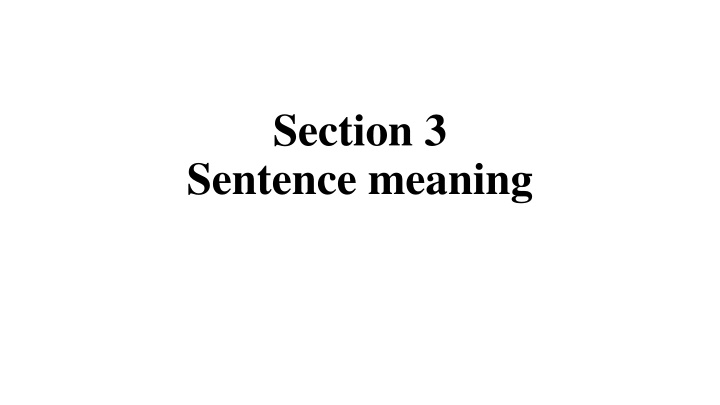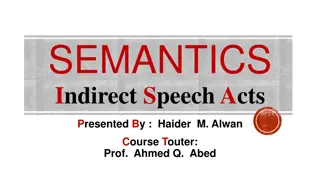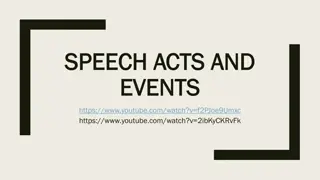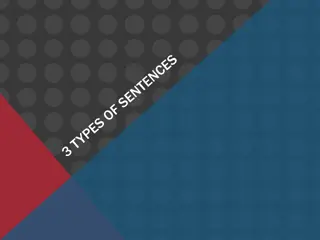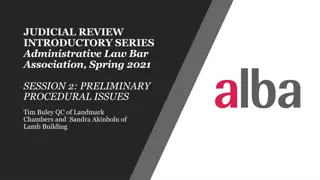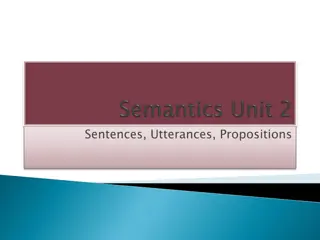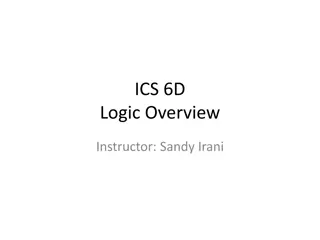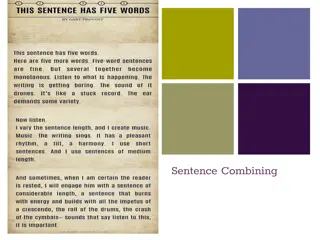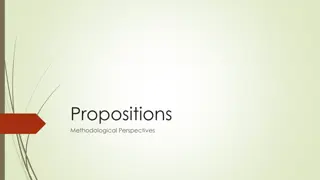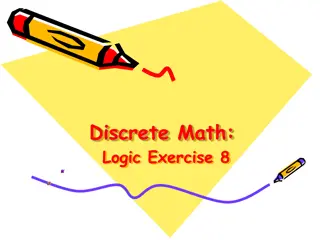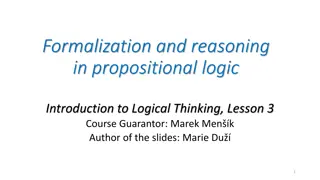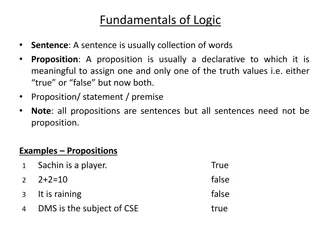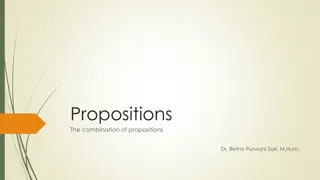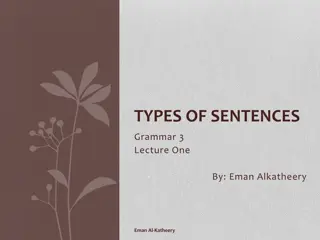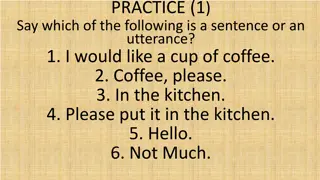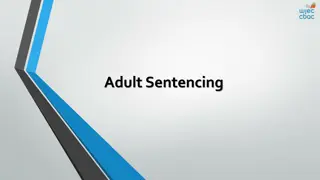Propositions, Sentences, Utterances
Distinctions between propositions, sentences, and utterances in language. Learn how a proposition relates to the meaning of a declarative sentence, understand the differences between propositions and sentences, and grasp the concepts of phonemes, syllables, morphemes, and more.
Download Presentation

Please find below an Image/Link to download the presentation.
The content on the website is provided AS IS for your information and personal use only. It may not be sold, licensed, or shared on other websites without obtaining consent from the author.If you encounter any issues during the download, it is possible that the publisher has removed the file from their server.
You are allowed to download the files provided on this website for personal or commercial use, subject to the condition that they are used lawfully. All files are the property of their respective owners.
The content on the website is provided AS IS for your information and personal use only. It may not be sold, licensed, or shared on other websites without obtaining consent from the author.
E N D
Presentation Transcript
Section 3 Sentence meaning
3.1. Proposition, utterance and sentence A PROPOSITION is that part of the meaning of the utterance of a declarative sentence which describes some state of affairs. Ex1. The following pair of sentences expresses the same proposition: 1(a) Harry took out the garbage. 1(b) Harry took the garbage out. 3(a) John gave Mary a book. 3(b) Mary was given a book by John. Ex2. The following pair of sentences expresses different propositions: 2(a) Jane loves Tony. 2(b) Tony loves Jane. 4(a) George danced with Anna. 4(b) George didn t dance with Anna.
Distinction between a proposition and a sentence Propositions, unlike sentences, cannot be said to belong to any particular language. Sentences in different languages can correspond to the same proposition, if the two sentences are perfect translations of each other. For example: English: I am cold. French: J ai froid. German: Mir ist kalt. Vietnamese: T i l nh. They are perfect translations of each other, be said to correspond to the same proposition.
Sound/phone table /teibl/ Letters (spelling) a b c k h t Sound (pronunciation) /a b k h /t/ /c/ Phoneme tea /ti:/ see /si:/ /i:/ long, close, front, spread, tense /t/ alveolar, plosive, voiceless Syllable Morpheme: teacher Word Phrase Sentence Utterance Paragraph Text
Distinction between a sentence & an utterance ASENTENCE is neither a physical event nor a physical object. It is conceived abstractly, a string of words put together by the grammatical rules of a language. A sentence can be thought of as the IDEAL string of words behind various realizations in utterances and inscriptions. An UTTERANCE is the USE by a particular speaker, on a particular occasion, for a particular purpose, of a piece of language, such as a sequence of sentences, or a single phrase, or even a single word.
Distinction between an utterance and a sentence a sentence is an abstract theoretical entity defined within a theory of grammar an utterance is the issuance of a sentence
Distinction between a proposition, a sentence and an utterance It is interesting to note that the same proposition can be expressed by different sentences and that the same sentence can be realized by different utterances on particular occasions.
3.2 Sentence types (classified according to truth value) An ANALYTIC sentence is one that is necessarily TRUE, as a result of the senses of the words in it. Example: - All elephants are animals. - Sam s wife is married. A CONTRADICTION/contradictory sentence, is a sentence that is necessarily FALSE, as a result of the senses of the words in it. Thus a contradiction is in a way the opposite of an analytic sentence. Example: - This animal is a vegetable. - Sam is older than himself.
3.2 Sentence types (classified according to truth value) A SYNTHETIC sentence is one which is NOT analytic, but may be either true or false, depending on the way the world is. Example: 1. John is from Ireland. There is nothing in the senses of John, Ireland or from which makes the sentence necessarily true or false. 2. Sam s wife is German. There is nothing in the senses of Sam s, wife or German which makes the sentence necessarily true or false.
3.3. Paraphrase - Definition - Paraphrase is the relationship between a word and a combination of other words with the same meaning. - When asked what a sentence means, people usually provide another sentence that has virtually the same meaning, a paraphrase. - A sentence which expresses the same proposition as another sentence is a paraphrase of that sentence. - Sentences are paraphrases if they have the same meaning (except possibly for minor differences in emphases).
Possible ways to paraphrase a sentence 1. Change individual words: a. using synonyms: Cats DRINK cream. Domestic felines CONSUME the liquid fat of milk. b. using relational antonyms (also called converses): I LENT that book to Jim. Jim BORROWED that book from me.
Possible ways to paraphrase a sentence 2. Change the structure Cats DRINK cream. Cream IS DRUNK by cats. 3. Change both individual words and sentence structure: Cats DRINK cream. The liquid fat of milk IS DRUNK by domestic felines.
3.4. Entailment Definition Entailment is a relationship that applies between two sentences, where the truth of one implies the truth of the other because of the meanings of the words involved. An entailment is something that logically follows from what is asserted in the utterance. Entailments are inferences that can be drawn solely from our knowledge about the semantic relationships in a language. This knowledge allows us to communicate much more than we actually say .
3.4. Entailment Characteristics Entailment applies cumulatively. Thus if X entails Y and Y entails Z, then X entails Z. X, Some boys ran down the street entails Y, Some kids ran down the street. Y, Some kids ran down the street entails Z, Some kids went down the street. Therefore X, Some boys ran down the street entails Z, Some kids went down the street.
3.4. Entailment Characteristics Hyponymy involves entailment. Example: This is a tulip entails This is a flower This is scarlet entails This is red The relation between tulip and flower and between scarlet and red brings out the HIERARCHICAL CLASSIFICATION involved in hyponymy
Types of entailment 1. One-way entailment: The entailments of this first type come about because of hyponymic relations between words: Example: Alfred saw a bear entails Alfred saw an animal. But Alfred saw an animal does not entail Alfred saw a bear. 2. Two-way entailment: The entailments between a pair of sentences are mutual since the truth of either sentence guarantees the truth of the other. Example: Paul borrowed a car from Sue entails Sue lent a car to Paul. The police chased the burglar entails The burglar was chased by the police.
